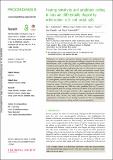Files in this item
Hearing sensitivity and amplitude coding in bats are differentially shaped by echolocation calls and social calls
Item metadata
| dc.contributor.author | Lattenkamp, Ella Z | |
| dc.contributor.author | Nagy, Martina | |
| dc.contributor.author | Drexl, Markus | |
| dc.contributor.author | Vernes, Sonja C | |
| dc.contributor.author | Wiegrebe, Lutz | |
| dc.contributor.author | Knörnschild, Mirjam | |
| dc.date.accessioned | 2021-04-29T15:30:04Z | |
| dc.date.available | 2021-04-29T15:30:04Z | |
| dc.date.issued | 2021-01-13 | |
| dc.identifier | 274004445 | |
| dc.identifier | 3b6c70c5-42a8-428c-8530-a5fb4489440d | |
| dc.identifier | 33402076 | |
| dc.identifier | 85099422715 | |
| dc.identifier.citation | Lattenkamp , E Z , Nagy , M , Drexl , M , Vernes , S C , Wiegrebe , L & Knörnschild , M 2021 , ' Hearing sensitivity and amplitude coding in bats are differentially shaped by echolocation calls and social calls ' , Proceedings of the Royal Society B: Biological Sciences , vol. 288 , no. 1942 , 20202600 . https://doi.org/10.1098/rspb.2020.2600 | en |
| dc.identifier.issn | 0962-8452 | |
| dc.identifier.other | PubMedCentral: PMC7892409 | |
| dc.identifier.other | ORCID: /0000-0003-0305-4584/work/93161708 | |
| dc.identifier.uri | https://hdl.handle.net/10023/23102 | |
| dc.description | This study was financed by a Heisenberg Fellowship (DFG KN935 5-1) awarded to M.K. and a Human Frontier Science Program Research grant no. (RGP0058/2016) awarded to L.W. and S.C.V. S.C.V. was also funded by the Max Planck Society. M.D. received funding from a grant of the German Ministry of Education and Research (BMBF) to the German Centre for Vertigo and Balance Disorders (01EO1401). E.Z.L. was funded by a short-term stipend of the German Academic Exchange Program (DAAD) (no. 57438025) and a travelling fellowship of the Company of Biologists (JEBTF18113). Moreover, the research leading to these results has received funding from the European Research Council under the European Union's Horizon 2020 Programme (2014–2020)/ERC GA 804352. | en |
| dc.description.abstract | Differences in auditory perception between species are influenced by phylogenetic origin and the perceptual challenges imposed by the natural environment, such as detecting prey- or predator-generated sounds and communication signals. Bats are well suited for comparative studies on auditory perception since they predominantly rely on echolocation to perceive the world, while their social calls and most environmental sounds have low frequencies. We tested if hearing sensitivity and stimulus level coding in bats differ between high and low-frequency ranges by measuring auditory brainstem responses (ABRs) of 86 bats belonging to 11 species. In most species, auditory sensitivity was equally good at both high- and low-frequency ranges, while amplitude was more finely coded for higher frequency ranges. Additionally, we conducted a phylogenetic comparative analysis by combining our ABR data with published data on 27 species. Species-specific peaks in hearing sensitivity correlated with peak frequencies of echolocation calls and pup isolation calls, suggesting that changes in hearing sensitivity evolved in response to frequency changes of echolocation and social calls. Overall, our study provides the most comprehensive comparative assessment of bat hearing capacities to date and highlights the evolutionary pressures acting on their sensory perception. | |
| dc.format.extent | 10 | |
| dc.format.extent | 882619 | |
| dc.language.iso | eng | |
| dc.relation.ispartof | Proceedings of the Royal Society B: Biological Sciences | en |
| dc.subject | Audiogram | en |
| dc.subject | Hearing threshold | en |
| dc.subject | Sensory system evolution | en |
| dc.subject | Amplitude coding | en |
| dc.subject | Dynamic range | en |
| dc.subject | Auditory brainstem responses | en |
| dc.subject | QH301 Biology | en |
| dc.subject | QL Zoology | en |
| dc.subject | DAS | en |
| dc.subject.lcc | QH301 | en |
| dc.subject.lcc | QL | en |
| dc.title | Hearing sensitivity and amplitude coding in bats are differentially shaped by echolocation calls and social calls | en |
| dc.type | Journal article | en |
| dc.contributor.institution | University of St Andrews. School of Biology | en |
| dc.contributor.institution | University of St Andrews. St Andrews Bioinformatics Unit | en |
| dc.identifier.doi | 10.1098/rspb.2020.2600 | |
| dc.description.status | Peer reviewed | en |
| dc.identifier.url | https://royalsocietypublishing.org/doi/suppl/10.1098/rspb.2020.2600#secSuppl | en |
This item appears in the following Collection(s)
Items in the St Andrews Research Repository are protected by copyright, with all rights reserved, unless otherwise indicated.

